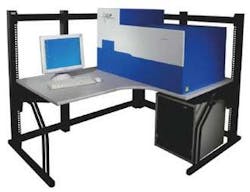An automated imaging and laser-based processing technology platform could have implications for purifying cells being studied in the laboratory and for removing malignant cells from a mixture of benign and cancerous cells. The technology allows individual cell analysis and manipulation in a high-content, high-throughput manner and can eliminate cells from the population by firing a laser at the unwanted cells.
The laser-enabled analysis and processing (LEAP) platform was developed by Oncosis (San Diego, CA) and is currently being perfected by its spinoff, Cyntellect. It rapidly images cells in situ through a combination of galvanometer and stage motions, achieving throughputs of more than 100,000 cells/s on any transparent surface.
According to the developers, LEAP provides both high-throughput, multiparameter cellular analysis and selective laser-based cellular manipulation. It can read cell-based assays, such as viability and apoptosis (cell death), in 1536 well plates in less than five minutes and can process several to several million cells with high yield.
Laser-enabled analysis and processing uses ultrahigh-speed optical scanning technologies and real-time image analysis to phenotype cells presented in several formats. The apparatus incorporates a high-speed targeting laser that can be fired at individual cells to be selectively eliminated, optoinjected (introduction of genes or macromolecules), photoactivated, interrogated, and manipulated based upon their phenotype. Because cells are processed in situ, more types of cells can be processed, increasing efficiency of processing, improving information content, and enabling cell-based experimentation.
In optoinjection, foreign macromolecules are introduced into cells by briefly making the cell membrane permeable with a focused laser beam, with little effect on cell viability. The microbeam is focused directly onto the plasma cell membrane for molecular delivery into that cell alone.
The system includes light-emitting-diode and xenon illumination and excitation, and has a magnification adjustable between 2.5× and 20×. Dual charge-coupled-device cameras provide imaging in bright-field, dark-field, phase-contrast, and multicolor fluorescence. The pulsed laser with galvanometer steering modifies or manipulates individual cells, while software performs control and image and data analysis. The technology can be used in pharmaceutical research, drug discovery, and life-science research.
Cyntellect is collaborating with the University of Texas at Galveston under a grant from the National Institutes of Health to study the effectiveness of chemically modified DNA decoys that can alter the cellular response to pathogens to protect the population against potential bioterrorism pathogen threats. It is also being used to purify rare cell populations for gene expression analysis in an HIV infection model.
Clinical applications
While Cyntellect focuses on research applications, Oncosis is pursuing clinical applications. The device could improve a cancer patient's chances of living a normal life by preventing cancer cells from invading the body, according to the company's engineers. It would be designed for use on the blood of a person who needs a stem-cell transplant.
"Mirrors turn very quickly and allow us to point the mirrors at individual cells at rapid speeds. We can shoot 1000 cells per second with this laser, even though the cells are in different positions," explains Manfred Koller, Cyntellect's vice president of research and development and chief operating officer.
In the case of a patient with non-Hodgkins lymphoma, for example, stem cells are usually removed and frozen before chemotherapy. After the procedure, those cells are thawed and prepared for reinsertion into the patient's body. "Unfortunately, some tumor cells can go along for the ride with the stem-cell harvest," says Koller. "This technology was developed to shoot the tumor cells in the stem-cell transplant, before going back in the body."
In the lab, scientists stain the cells so that the cancerous ones glow. Oncosis has identified all the cells for targeting by the laser, which starts killing each one of the cells. The computer sorts through thousands of cells per second. The instrument scans image-by-image looking for cancer cells; the laser then kills them instantly. "When we shoot a cell, we immediately know that we shot it and it's gone," says Koller.
